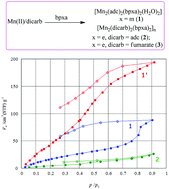Ancillary ligand assisted self-assembly of coordination architectures of Mn(ii): the effect of the N-alkyl group on a tridentate ligand†
Abstract
For a subtle change in the N-alkyl group of the tridentate ancillary ligand, bis(2-pyridylmethyl)alkylamine (where the alkyl group = methyl (bpma) or ethyl (bpea)), completely different products are formed under similar reaction (in methanol) as well as crystallization conditions (in water). One containing coordinated water molecules is the 3D supramolecular assembly of a tetrameric synthon comprised of the dimeric subunits, [Mn2(adc)2(bpma)2(H2O)2] (1), organized by strong hydrogen bonding while the other without a coordinated water molecule forms the 1D coordination polymer, [Mn2(adc)2(bpea)2]n (2) (where adc = acetylene dicarboxylate), featuring a uninodal 4-connected SP 1-periodic net (3,6)(1,2) for 1D→2D with the point group {3^3.4^2.5}. Unlike 1, two chains of 1D CP in 2 have a moderate π–π interaction between two corresponding pyridine rings (the centroid–centroid distance: 3.659 Å) resulting in the formation of a ladder like supramolecular assembly. On the other hand, there is no effect in changing the dicarboxylate linker from adc to fumarate as the product [Mn2(fumarate)2(bpea)2]n (3) is found to be similar to 2. All these are also characterized by elemental analysis, powder X-ray diffraction (PXRD), FTIR and Raman spectroscopy. Their thermal stability was studied by thermogravimetric analysis. Based on variable temperature PXRD studies, compounds 1 and 2 retain their crystallinity and overall structure up to 100 °C and 175 °C, respectively. The water vapor adsorption study of 1 and 2 corroborates well with their solid state structures determined by single crystal X-ray diffraction, specifically their affinity towards water; furthermore, the study of 1 with or without pre-treatment conditions shows its structural integrity intact due to dehydration.


 Please wait while we load your content...
Please wait while we load your content...